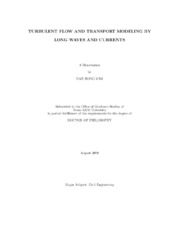| dc.description.abstract | This dissertation presents models for turbulent flow and transport by currents
and long waves in large domain.
From the Navier-Stokes equations, a fully nonlinear depth-integrated equation
model for weakly dispersive, turbulent and rotational flow is derived by a perturbation
approach based on long wave scaling. The same perturbation approach is applied
for the derivation of a depth-integrated transport equation. As the results, coherent
structures generated by the turbulence induced by the bottom friction and topography
can be predicted very reasonably.
The three dimensional turbulence effects are incorporated into the flow model by
employing a back scatter model. The back scatter model makes it possible to predict
turbulent transport: It contributes to the energy transport and the lateral turbulent
diffusion through relying on the turbulent intensity, not by relying on an empirical
diffusion constant. The inherent limitation of the depth-integrated transport equation,
that is, the limitation for the near field prediction is recognized in the derivation
and the numerical simulation.
To solve the derived equation set, a highly accurate and stable finite volume
scheme numerical solver is developed. Thus, the numerical solver can predict dispersive
and nonlinear wave propagation with minimal error. Also, good stability is
achieved enough to be applied to the dam-break flows and undular tidal bores. In addition, a robust moving boundary scheme based on simple physical conditions is
presented, which can extend the applicability area of the depth-integrated models.
By the comparison study with experimental data, it is expected that the numerical
model can provide high confidence results for the wave and current transformations
including shocks and undular bores on complex bathymetry and topography. For
the accurate near field transport prediction, a three dimensional transport model in
?-coordinate coupled with the depth-integrated flow model is developed. Like the
other models, this model is also intended for large domain problems, and yet efficient
and accurate in the far field and near field together. | en |


